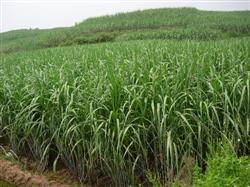Symptoms and Control methods of phosphorus deficiency in Sugarcane

First, the symptoms of phosphorus deficiency in sugarcane: underdeveloped roots, slow growth and few tillers. The growth of the aboveground part is poor, the sugarcane node is short, the leaves are obviously green-blue at the initial stage, and then become yellowish green, the leaf tip and leaf edge are dry, and some leaves can show obvious purple and abnormal upright posture. When sugarcane is seriously deficient in phosphorus, the leaves of the plant are very narrow and produce a large number of white parties and freckles. Second, prevention and control methods: 1, the application of phosphate fertilizer should be early, it is best to use it as base fertilizer when planting. 2. Ploughing should be advanced and phosphate fertilizer should be increased. Apply as close to the root system as possible to make sugarcane easy to absorb. 3. Soil testing and fertilization can be carried out if possible. When the concentration of phosphoric acid in the soil meets the needs of sugarcane, the application of phosphate fertilizer is useless, while the slightly acidic soil can increase the solubility of phosphorus, so the effect of applying phosphate fertilizer is good, and the application of slightly alkaline calcium magnesium phosphate fertilizer in acidic soil is better than calcium superphosphate.
- Prev

Six points of sugarcane can be planted in winter with high yield.
Planting sugarcane in winter can not only be high-yielding, early-maturing, but also stagger in farming season, it is easy to arrange land stubble, sugarcane species are also easy to solve, and the yield per 667 square meters is 5% higher than that of spring-planted sugarcane. 1. Land preparation should select plots with deep soil layer, middle and upper fertility, loose soil and strong water retention. After deep ploughing and fine harrowing, the row spacing is 90.
- Next

Drought resistance technology of sugarcane
1. Select improved varieties with disease resistance and reasonable crop rotation. two。 Fertilizing the soil, increasing the application of organic fertilizer and applying more phosphorus and potassium fertilizer can reduce the occurrence of brown streak. 3. Remove the seriously diseased leaves in time, reduce the source of bacteria in the field, and control the spread. 4. Peel off the old foot leaves, occasionally remove ineffective, sick and weak plants, make the sugarcane field ventilated and reduce the sugarcane field.
Related
- Moge, come on! The staff of the peasant association in the producing area of cantaloupe were frightened when the crowd gathered.
- Causes and Solutions of low Fruit setting rate of Apple
- Symptoms and control measures of passion fruit virus disease
- Fruit growing lesson: how do apple orchards keep high yields?
- Can you build orchards in the mountains? What are the pros and cons?
- How to manage the coloring period of Crisson grape?
- This paper introduces the processing technology of two kinds of fig products.
- How much is a month for retired teachers in rural areas by 2020?
- How can strawberry planting increase sugar content? We should pay attention to management in many aspects.
- What are the cultivation techniques on how to improve the yield of golden fruit?

